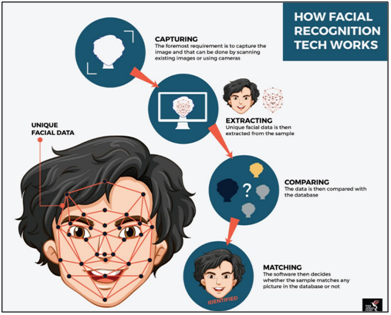

Context
Right to Information (RTI) responses, reveals that the Delhi Police treats matches of above 80% similarity generated by its facial recognition technology (FRT) system as positive results.
About
Why is the Delhi Police using facial recognition technology?
- The Delhi Police first started using FRT to trace and identify missing children as per a 2018 direction of the Delhi High Court in Sadhan Haldar vs NCT of Delhi.
- Delhi police later made use of this technology to investigate the anti-CAA protests in 2019.
- It has also used FRT specifically during the 2020 northeast Delhi riots, the 2021 Red Fort violence, and the 2022 Jahangirpuri riots.
|
Why is the use of FRT harmful?
- Misidentification Due to Inaccuracy of The Technology:
- It can result in a false positive, where a person is misidentified as someone else, or a false negative where a person is not verified as themselves.
| One example of such “exclusion” is the failure of the biometric-based authentication under Aadhaar which has led to many people being excluded from receiving essential government services which in turn has led to starvation deaths. |
- Mass Surveillance Due to Misuse of The Technology
- Violation of Internationally recognized best practices
What does the right to Information Responses reveal?
- Lack of reasoning behind the 80% similarity as the threshold: The Delhi Police has revealed that matches above 80% similarity are treated as positive results while matches below 80% similarity are treated as false positive results which may require human intervention.
- It is unclear why 80% has been chosen as the threshold between positive and false positive.
- Categorization of below 80% results: The categorization of below 80% results as false positive instead of negative shows that the Delhi Police may still further investigate below 80% results.
- Thus, people who share familial facial features, such as in extended families or communities, could end up being targeted.
- Overboard collection of Data: Delhi Police is matching the photographs/videos against photographs collected under Sections 3 and 4 of the Identification of Prisoners Act, 1920, which has now been replaced by the Criminal Procedure (Identification) Act, 2022.
- It may result in a violation of internationally recognized best practices for the collection and processing of data.
|
Criminal Procedure (Identification) Act, 2022:
|
Need for regulatory frameworks:
- The usefulness of facial recognition tech in countering terrorism can only increase in parallel with the sophistication levels of the tech itself, but this would also highlight the risks of data privacy in managing large-scale data collection.



